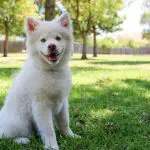Curly coated retriever puppy and dog information
The Curly-Coated Retriever is not an apartment dog. She needs at the minimum, a properly fenced in enclosure to romp and burn off her energy. Ideally, she should have access to recreational water occasionally because she lives to swim and fetch. She is generally good with older children. She makes a good watch dog and a great family dog but she may not get along with other pets.
*Approximate Adult Size. The approximate adult size (two years old or older) of the male Curly-Coated Retriever is 25 to 27 inches to the withers (highest point of the shoulder). The female ranges from 23 to 25 inches to the withers and both will range from 65 to 80 pounds.
*Special Health Considerations. Most dog breeds have certain inherited health problems associated with that specific breed and the Curly-Coated Retriever is no exception. Be on the look out for canine hip dysplasia (genetic based looseness in the hip joint that can lead to arthritis pain and lameness), cancer, skin disorders, and epilepsy. This disease list is an informative guideline only. Other diseases may also be significant threats, please contact your veterinarian for a complete list.
She should visit the veterinarian several times in the first year for shots, boosters and check up. Then, as an adult, she should visit the veterinarian yearly for shots and check up. As she gets older, six years and on, she should visit the veterinarian twice a year for check ups and shots. Remember; avoid feeding your dog sweets.
*Grooming. The Curly-Coated Retriever has a coat of small, tight, water proof curls situated close to the skin. She does shed and should be brushed regularly. Brushing will help her maintain a clean and healthy coat, avoid mats and help you keep a closer eye on her health and strengthen your emotional bond with her.
Her teeth should be brushed at least twice a week with toothpaste and toothbrush designed for dogs. Brushing removes the accumulation of plaque and tartar which can cause cavities (rarely) and periodontal disease. Dog periodontal disease can lead to pain, loss of teeth, bad breath and other serious disease.
Her toenails may need to be examined for growth and clipped regularly. The toenails of the rear feet grow slower than the toenails of the front feet. Generally a guillotine type trimmer is the best for this chore and competent instructions to accomplish this can be found on the net.
*Life Span. The Curly-Coated Retriever can live between 8 and 10 years with proper nutrition, medical care and excellent living conditions.
*History. The Curly-Coated Retriever came from Great Britain. They are an old retriever breed prized by game keepers. They are a cross between the Poodle, Irish Water Spaniel, English Water Spaniel and the Newfoundland. They are commonly found in Australia and New Zealand. They were first registered by the American Kennel Association in 1924.
Some Registries: *Curly-Coated Retriever Club of America *UKC United Kennel Club *NKC National Kennel Club *CKC Continental Kennel Club *APRI Americas Pet Registry Inc. *AKC American Kennel Club *FCI Federation Cynologique Internationale *NZKC New Zealand Kennel Club *KCGB = Kennel Club of Great Britain *ANKC = Australian National Kennel Club *ACR = American Canine Registry
Litter Size: 7 to 8 Curly-Coated Retriever puppies
Category: Sporting Gundog
*Terms To Describe: Proud, responsive, affectionate, balanced, robust, strong, grace, elegant, hard working, sturdy, durable, independent
*SPECIAL GOOD POINTS Good watch dog. High in obedience. High in intelligence. Love to swim.
*SPECIAL BAD POINTS Poor guard dog. May not do well with other dogs. Can be stubborn. Needs exercise and a job to do. She matures late, about 3 years.
*Other Names Known By: Gamekeepers Dog, Curlies
*Every dog is an individual so not everything in this information may be correct for your dog. This information is meant as a good faith guideline only.


